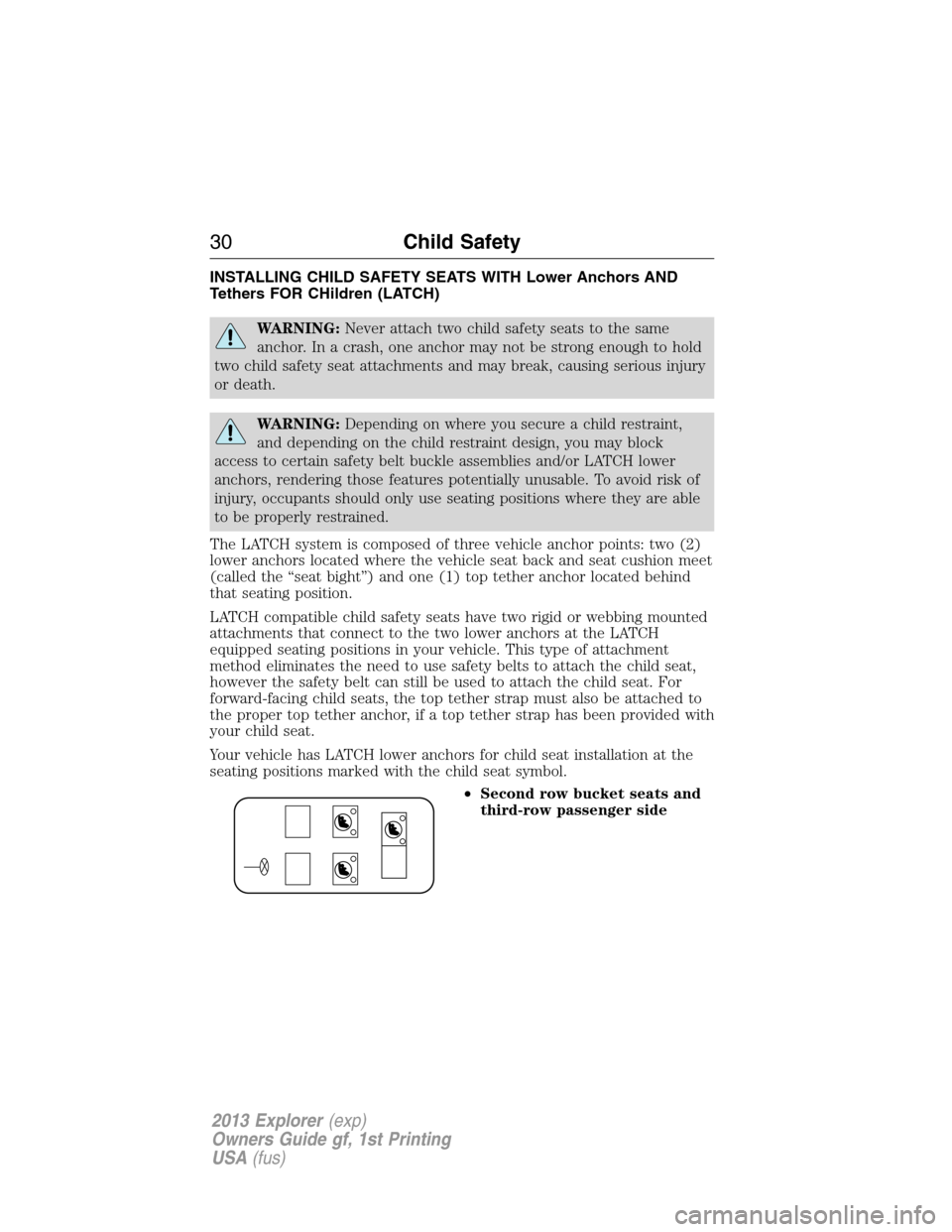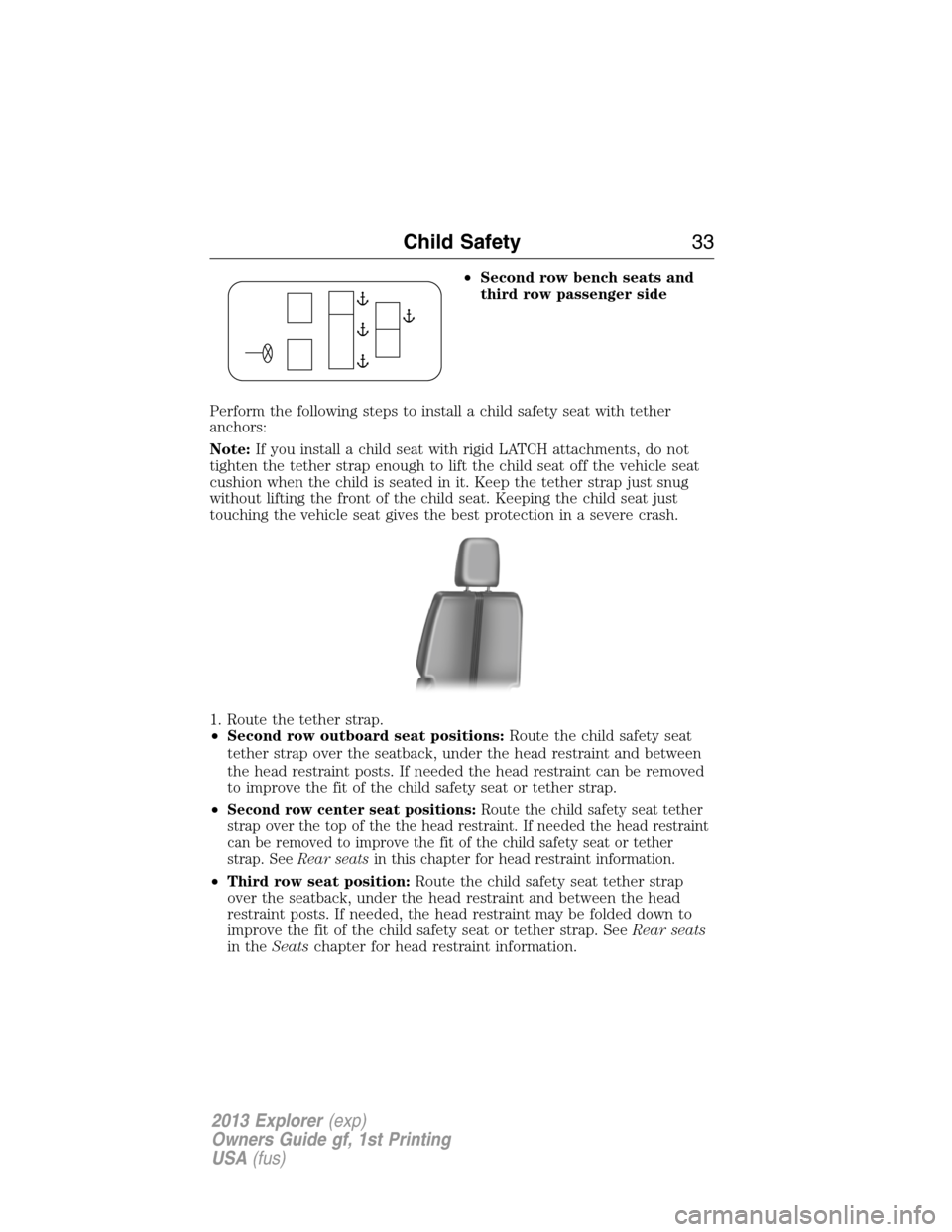Page 25 of 576

INSTALLING CHILD SEATS WITH LAP AND SHOULDER BELTS
WARNING:Airbags can kill or injure a child in a child seat.
NEVERplace a rear-facing child seat in front of an active airbag.
If you must use a forward-facing child seat in the front seat, move the
seat all the way back.
WARNING:Children 12 and under should be properly restrained
in the rear seat whenever possible.
WARNING:Depending on where you secure a child restraint,
and depending on the child restraint design, you may block
access to certain safety belt buckle assemblies and/or LATCH lower
anchors, rendering those features potentially unusable. To avoid risk of
injury, occupants should only use seating positions where they are able
to be properly restrained.
When installing a child safety seat with combination lap/shoulder belts:
•Use the correct safety belt buckle for that seating position.
•Insert the belt tongue into the proper buckle until you hear a snap and
feel it latch. Make sure the tongue is securely fastened in the buckle.
•Keep the buckle release button pointing up and away from the safety
seat, with the tongue between the child seat and the release button, to
prevent accidental unbuckling.
•Place vehicle seat back in upright position.
•For second row seating positions, if needed, the recliner may be
adjusted slightly to improve child seat fit. If needed the head restraints
may be removed.
•For third row seating positions the head restraints may be stowed to
improve child seat fit, if needed. Refer toRear seatsin theSeats
chapter for information on folding the head restraints.
•Put the safety belt in the automatic locking mode. Refer to Step 5
below. This vehicle does not require the use of a locking clip.
Perform the following steps when installing the child seat with
combination lap and shoulder belts:
Note:Although the child seat illustrated is a forward facing child seat,
the steps are the same for installing a rear facing child seat.
Child Safety25
2013 Explorer(exp)
Owners Guide gf, 1st Printing
USA(fus)
Page 26 of 576
Note:The ’Lock-off’ device on some child restraints may not accommodate
the shoulder portion of the inflatable safety belt. Follow all instructions
provided by the manufacturer of the child restraint regarding the necessary
and proper use of the ’Lock-off’ device. In some instances these devices
have been provided only for use in vehicles with safety belt systems that
would otherwise require a locking clip. This vehicle does not require the
use of a locking clip.
1. Position the child safety seat in a
seat with a combination lap and
shoulder belt.
2. After positioning the child safety seat in the proper seating position,
do the following:
•Standard safety belt: pull down
on the shoulder belt and then
grasp the shoulder belt and lap
belt together behind the belt
tongue.
•Inflatable safety belt: grasp the
shoulder belt and lap belt together
behind the belt tongue.
26Child Safety
2013 Explorer(exp)
Owners Guide gf, 1st Printing
USA(fus)
Page 28 of 576

5. To put the retractor in the automatic locking mode, do the following;
•Standard safety belt: grasp the
shoulder portion of the belt and
pull downward until all of the belt
is pulled out.
•Inflatable safety belt: grasp the lap
portion of the inflatable safety belt
and pull upward until all of the belt
is pulled out.
Note:Unlike the standard safety belt, the inflatable safety belt’s unique
lap portion locks the child seat for installation. The ability for the
shoulder portion of the belt to move freely is normal, even after the lap
belt has been put into the automatic locking mode.
6. Allow the belt to retract to remove slack. The belt will click as it
retracts to indicate it is in the automatic locking mode.
7. Try to pull the belt out of the retractor to make sure the retractor is in
the automatic locking mode (you should not be able to pull more belt
out). If the retractor is not locked, repeat Steps 5 and 6.
8. Remove remaining slack from the belt. Force the seat down with extra
weight, e.g., by pressing down or kneeling on the child restraint while
pulling up on the shoulder belt (for standard safety belt) or pulling down
on the lap belt (for inflatable safety belt) in order to force slack from the
belt. This is necessary to remove the remaining slack that will exist once
the additional weight of the child is added to the child restraint. It also
helps to achieve the proper snugness of the child seat to the vehicle.
Sometimes, a slight lean towards the buckle will additionally help to
remove remaining slack from the belt.
28Child Safety
2013 Explorer(exp)
Owners Guide gf, 1st Printing
USA(fus)
Page 29 of 576
•Standard safety belt
•Inflatable safety belt
9. Attach the tether strap (if the child seat is equipped). Refer to
Installing child safety seats with tether strapslater in this chapter.
10. Before placing the child in the
seat, forcibly move the seat forward
and back to make sure the seat is
securely held in place. To check
this, grab the seat at the belt path
and attempt to move it side to side
and forward and back. There should
be no more than 1 inch (2.5 cm) of
movement for proper installation.
Ford recommends checking with a NHTSA Certified Child Passenger
Safety Technician (CPST) to make certain the child restraint is properly
installed. In Canada, check with your local St. John Ambulance office for
referral to a CPST.
Child Safety29
2013 Explorer(exp)
Owners Guide gf, 1st Printing
USA(fus)
Page 30 of 576

INSTALLING CHILD SAFETY SEATS WITH Lower Anchors AND
Tethers FOR CHildren (LATCH)
WARNING:Never attach two child safety seats to the same
anchor. In a crash, one anchor may not be strong enough to hold
two child safety seat attachments and may break, causing serious injury
or death.
WARNING:Depending on where you secure a child restraint,
and depending on the child restraint design, you may block
access to certain safety belt buckle assemblies and/or LATCH lower
anchors, rendering those features potentially unusable. To avoid risk of
injury, occupants should only use seating positions where they are able
to be properly restrained.
The LATCH system is composed of three vehicle anchor points: two (2)
lower anchors located where the vehicle seat back and seat cushion meet
(called the “seat bight”) and one (1) top tether anchor located behind
that seating position.
LATCH compatible child safety seats have two rigid or webbing mounted
attachments that connect to the two lower anchors at the LATCH
equipped seating positions in your vehicle. This type of attachment
method eliminates the need to use safety belts to attach the child seat,
however the safety belt can still be used to attach the child seat. For
forward-facing child seats, the top tether strap must also be attached to
the proper top tether anchor, if a top tether strap has been provided with
your child seat.
Your vehicle has LATCH lower anchors for child seat installation at the
seating positions marked with the child seat symbol.
•Second row bucket seats and
third-row passenger side
30Child Safety
2013 Explorer(exp)
Owners Guide gf, 1st Printing
USA(fus)
Page 33 of 576

•Second row bench seats and
third row passenger side
Perform the following steps to install a child safety seat with tether
anchors:
Note:If you install a child seat with rigid LATCH attachments, do not
tighten the tether strap enough to lift the child seat off the vehicle seat
cushion when the child is seated in it. Keep the tether strap just snug
without lifting the front of the child seat. Keeping the child seat just
touching the vehicle seat gives the best protection in a severe crash.
1. Route the tether strap.
•Second row outboard seat positions:Route the child safety seat
tether strap over the seatback, under the head restraint and between
the head restraint posts. If needed the head restraint can be removed
to improve the fit of the child safety seat or tether strap.
•
Second row center seat positions:Route the child safety seat tether
strap over the top of the the head restraint. If needed the head restraint
can be removed to improve the fit of the child safety seat or tether
strap. SeeRear seatsin this chapter for head restraint information.
•Third row seat position:Route the child safety seat tether strap
over the seatback, under the head restraint and between the head
restraint posts. If needed, the head restraint may be folded down to
improve the fit of the child safety seat or tether strap. SeeRear seats
in theSeatschapter for head restraint information.
Child Safety33
2013 Explorer(exp)
Owners Guide gf, 1st Printing
USA(fus)
Page 35 of 576
3. Clip the tether hook to the anchor as shown. The tether hook may be
twisted 1/2 turn to improve installation.
If the tether strap is clipped incorrectly, the child safety seat may not be
retained properly in the event of a collision.
4. Tighten the child safety seat tether strap according to the
manufacturer’s instructions.
If the safety seat is not anchored properly, the risk of a child being
injured in a collision greatly increases.
If your child restraint system is equipped with a tether strap, and the
child restraint manufacturer recommends its use, Ford also recommends
its use.
Child Safety35
2013 Explorer(exp)
Owners Guide gf, 1st Printing
USA(fus)
Page 37 of 576

PRINCIPLES OF OPERATION
WARNING:Always drive and ride with your seatback upright
and the lap belt snug and low across the hips.
WARNING:To reduce the risk of injury, make sure children sit
where they can be properly restrained.
WARNING:Never let a passenger hold a child on his or her lap
while the vehicle is moving. The passenger cannot protect the
child from injury in a collision.
WARNING:All occupants of the vehicle, including the driver,
should always properly wear their safety belts, even when an
airbag supplemental restraint system (SRS) is provided.
WARNING:It is extremely dangerous to ride in a cargo area,
inside or outside of a vehicle. In a collision, people riding in these
areas are more likely to be seriously injured or killed. Do not allow
people to ride in any area of your vehicle that is not equipped with
seats and safety belts. Be sure everyone in your vehicle is in a seat and
using a safety belt properly.
WARNING:In a rollover crash, an unbelted person is
significantly more likely to die than a person wearing a safety
belt.
WARNING:Each seating position in your vehicle has a specific
safety belt assembly which is made up of one buckle and one
tongue that are designed to be used as a pair. 1) Use the shoulder belt
on the outside shoulder only. Never wear the shoulder belt under the
arm. 2) Never swing the safety belt around your neck over the inside
shoulder. 3) Never use a single belt for more than one person.
WARNING:When possible, all children 12 years old and under
should be properly restrained in a rear seating position.
Safety Belts37
2013 Explorer(exp)
Owners Guide gf, 1st Printing
USA(fus)